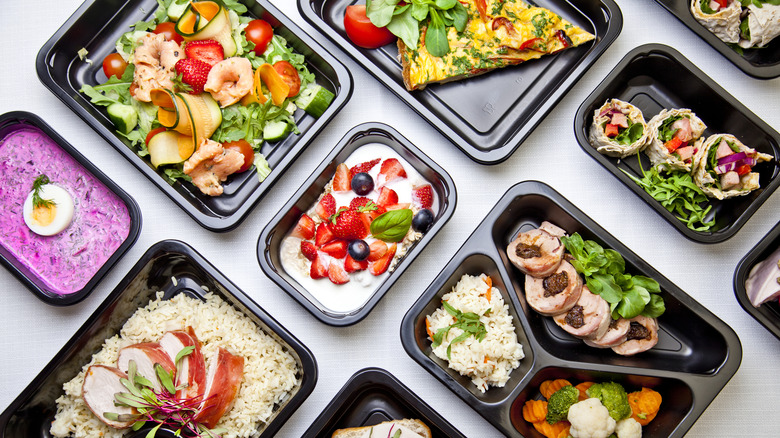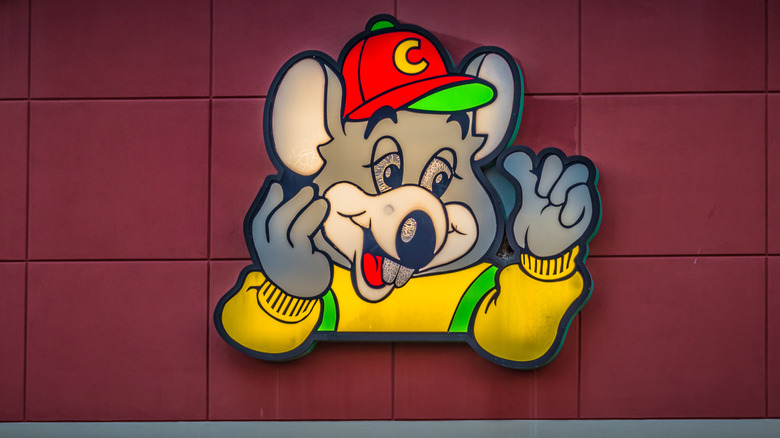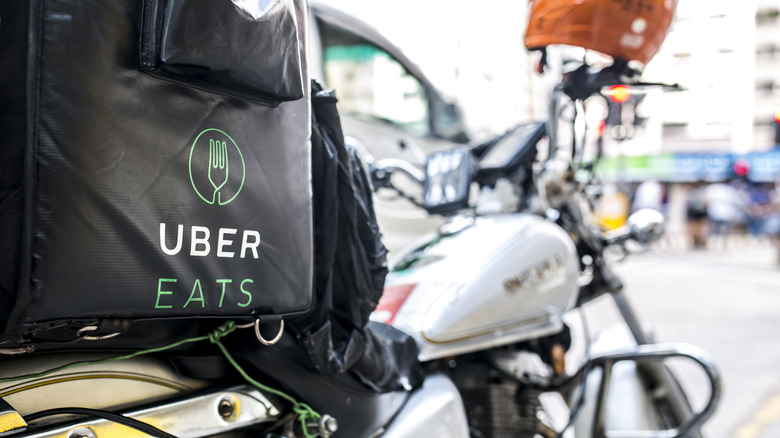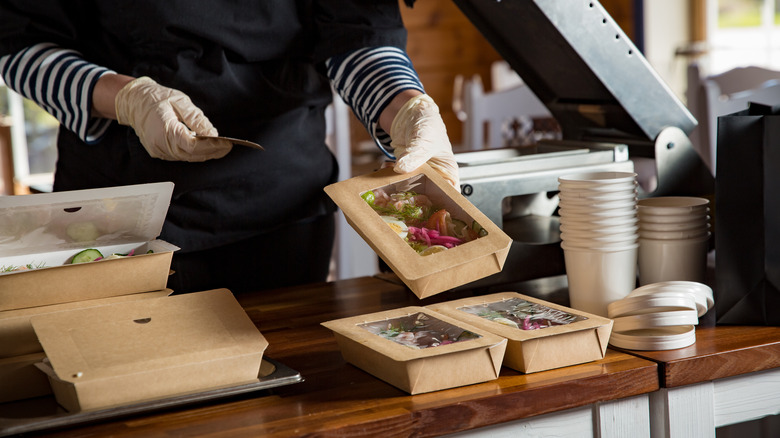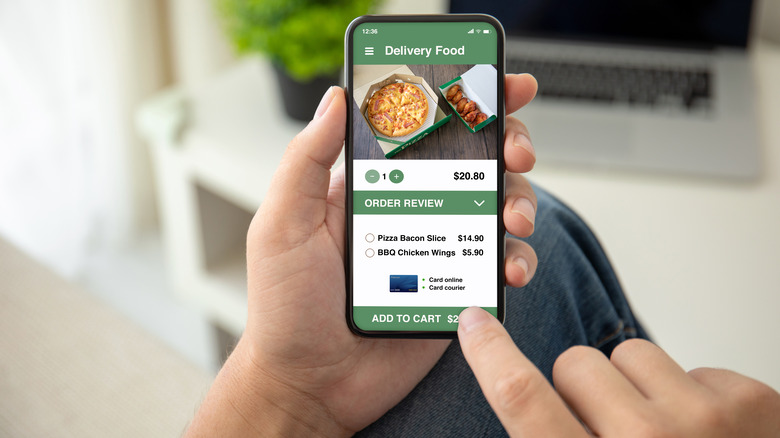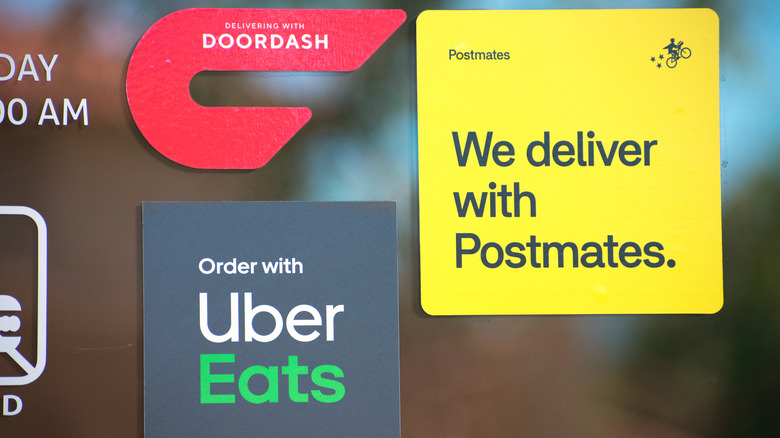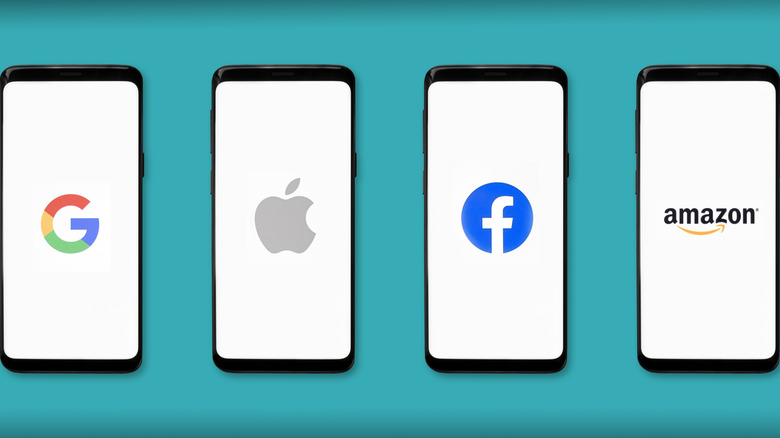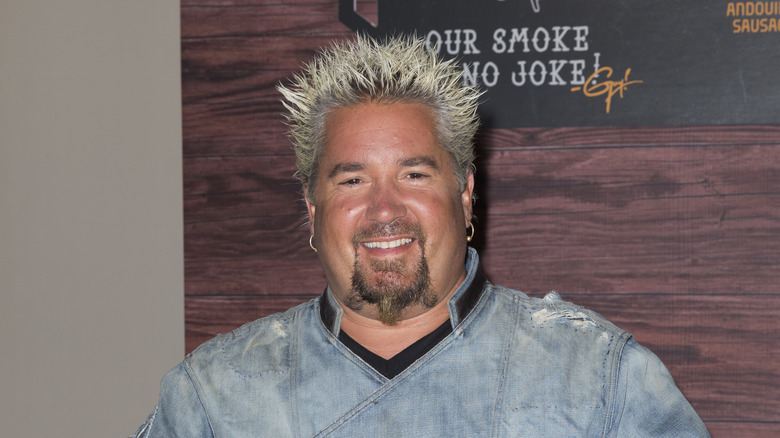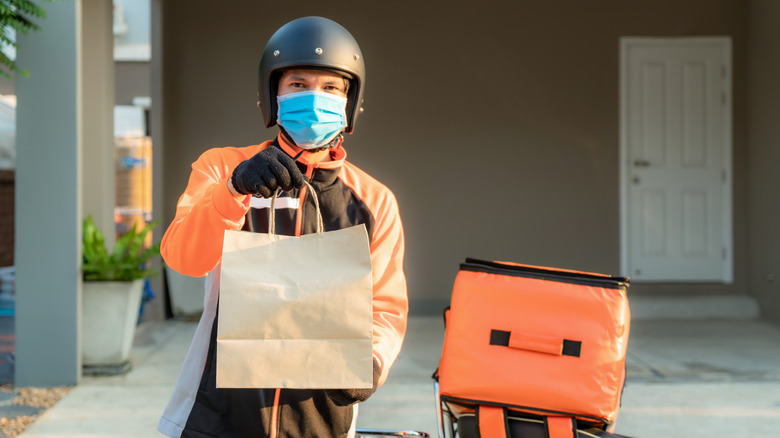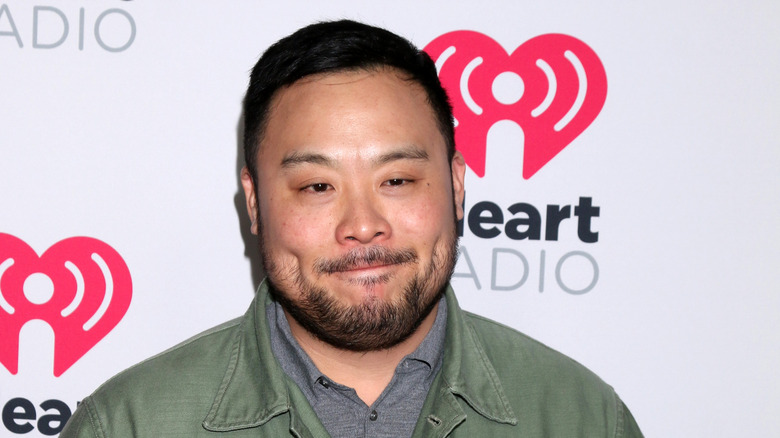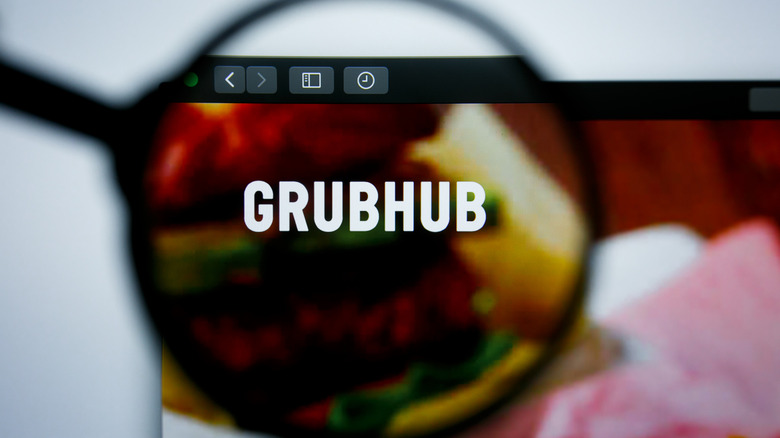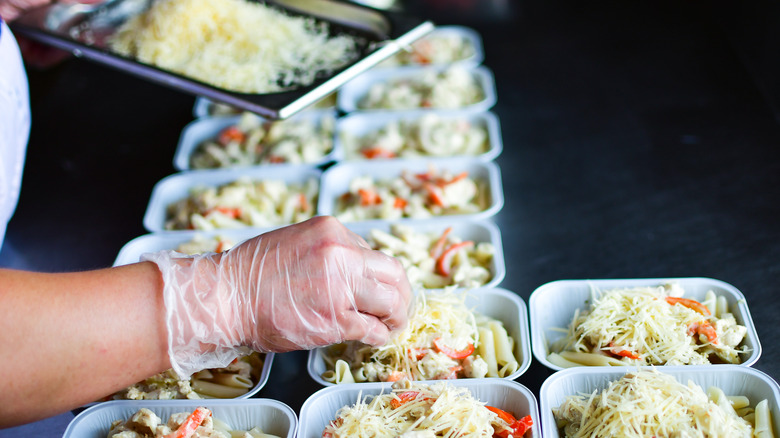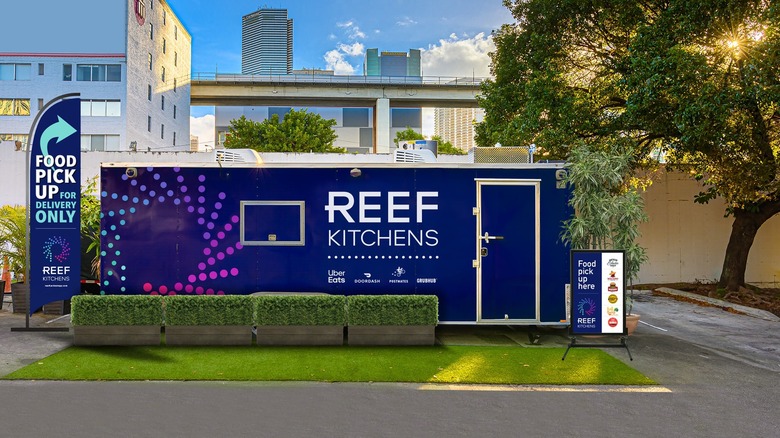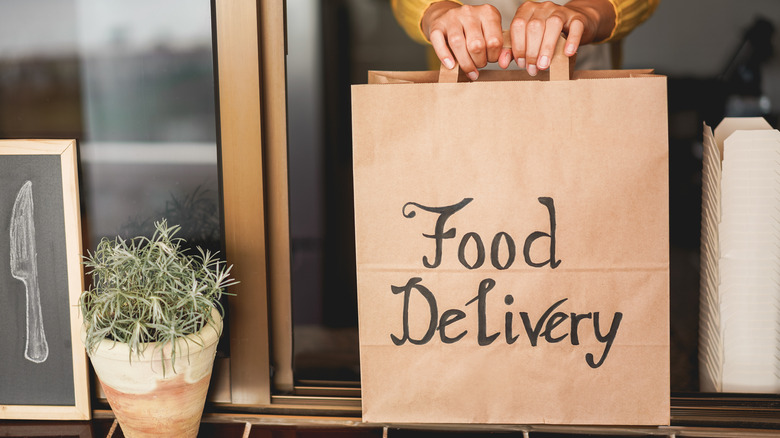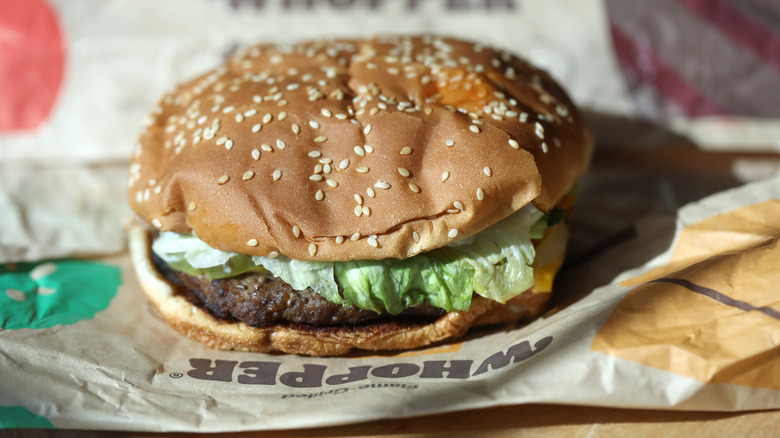What You Need To Know About Ghost Kitchens
If you've ordered from a food delivery app, chances are, you've encountered a ghost kitchen and didn't even know it. You might've used a delivery app to order from one of your favorite chains or a nondescript restaurant selling chicken wings. The term "ghost kitchen" or "cloud kitchen" describes commercial kitchens designed to make food only for delivery. You won't find seating, a host, or even bathrooms. Delivery-only isn't a new concept since many restaurants like pizza places have capitalized on this model for decades. That said, the growth of apps like Uber Eats, Grubhub, and DoorDash and the global shutdown changed the way people eat out.
Marker found the "equivalent of 90% of the U.S. population" began ordering delivery services in 2020. Restaurant Dive reports increased focus on takeout even before 2020 with more than half of respondents in a National Restaurant Association survey saying apps were more important than two years prior. Restaurant Owner reports delivery platforms are expecting over $43 billion spent on food delivery by 2022. In other words, the delivery trend is expected to stick around.
The lower costs for running a ghost kitchen can't be ignored. Entrepreneur explains ghost kitchens eliminate dining room expenses, lower rents, and reduce labor. The reality of ghost kitchens can be less appetizing due to missing regulations, social media angst, failed celebrity brands, and Silicon Valley tracking everything you eat. The real question is who is making our food?
A ghost kitchen might be masquerading as you favorite brand — or as a local shop
Many customers won't buy food from a name they don't recognize, and for good reason. To solve this problem of name recognition, Entrepreneur reports ghost kitchens are building customers by partnering with well-known brands to expand their delivery reach through commercial kitchens. Where the model gets complicated is that the news site claims some ghost kitchens will build a reputation, then drop the franchise fees of a big name before switching to their own brand. The customer all the while doesn't realize what's going on behind the scenes.
Roaming Hunger explains that a popular restaurant such as Canter's diner in West Hollywood rents facilities for multiple ghost kitchens, but when someone orders from the app the customer assumes the sandwich is coming from the original location. Most people might not care if they trust the brand. Marker reports Chipotle is taking on this model to reach untapped markets while fast-food brands Chick-fil-A and Arby's use catering kitchens to replace drive-thru sales.
Some brands are using alternative names that sound like a mom-and-pop shop. For example, a user on Reddit revealed that Chuck E. Cheese used the name "Pasqually's Pizza & Wings" to sell its food in Philadelphia through Grubhub. The chain was listed under the fake restaurant in locations across the country. The takeaway here is to do a little bit of research on new brands if you don't want wings from a cartoon rat.
Ghost kitchens rely on expensive delivery apps at a cost to customers
Anyone who's received soggy, cold delivery to their door knows running a successful delivery restaurant relies on more than just good food. Entrepreneur reports delivery is a challenge for many brands and apps can squeeze out 20% to 30% from the cost of each order. Business Insider explains those costs don't even include credit card fees. Most restaurants operate with small profits, so any loss to their margins can be devastating. Ghost kitchens are supposed to fix this issue by eliminating other costs such as additional labor, the site says. Some restaurants argue this isn't true.
Delivery apps aren't aiming added costs only at restaurants. The New York Times found delivery apps will increase costs not only by adding service fees, delivery fees, and "miscellaneous" fees to customers, but some restaurants will list meals for a higher price on the app than in the restaurant. The report found Uber Eats to be the most egregious with markups of 91% more than if you had walked into the building yourself, as well as 61% with Postmates, 46% with DoorDash, and 25% for Grubhub. We'll let that sink in as you check your bank account.
Ghost Kitchens are only temporary options for some restaurateurs
Ghost kitchens turned out to be a temporary solution in the face of shuttered dining rooms. Bon Appétit says small and independent restaurants are moving to the less-conventional kitchen spaces, such as Baltimore chef Jasmine Norton renting from a hotel, to produce delivery and takeout. The article says the chef reduced profits by 90% from her location as a neighborhood oyster bar before the pandemic. To be fair, how many people are truly looking to order oysters on demand?
On a much different scale, Restaurant Business reports Wendy's is using temporary ghost kitchens to reach areas in cities around Canada, but also in Los Angeles, Chicago, the Dominican Republic, and the Philippines, where finding a drive-thru location has proved difficult. The fast-food chain partnered with one of the major players in the ghost kitchen industry, Reef. Seriously, these guys are either everywhere or their PR department is working overtime. Reef makes food on behalf of brands like Wendy's claiming to use "different frameworks" to experiment in this expanding landscape, says Restaurant Business. The emphasis on a ghost kitchen as a temporary solution might signal that the boom for commercial spaces might not have the longevity that tech investors hope.
Only the most basic foods seem to be successful
Don't expect huge innovation to be coming from ghost kitchens, at least not in terms of menu. Restaurant Owner found for most "successful" ghost kitchens are run by a third-party umbrella company, such as CloudKitchen or Reef, employing its own delivery staff and crafting multiple types of food from one kitchen. Often the ghost kitchens operate their own brands, but the outlet says the key is a paired down and flexible menu. Specialy sourced ingredients or a niche cooking expertise doesn't play well. The idea is to sell comfort foods anyone can make with minimal experience and reach across as many apps as possible.
Virginia's 13 News Now tracked how large and small brands are using the popularity of delivery apps to create menu favorites — think fries, burgers, and Indian takeout — under what are listed as separate brands focusing on a single dish or a handful of related dishes. The news outlet listed a Norfolk Indian restaurant selling "deconstructed samosas" and a hot pot restaurant selling ramen, each under different names run by a third-party ghost kitchen. It might sound like a great side hustle for small businesses, but the site says it's often corporate brands such as Chilis, Applebees, or Ruby Tuesday selling "just wings" under a different name. Classic bait and switch or business as usual? You decide.
Low costs doesn't equal success
Ever wonder why a brunch place selling a $12 pancake might complain about how tough business is? Modern restaurants are expensive with unpredictable operations. Marker explains the median starting price of a new restaurant can be about "$450 to $525 per square foot." By December 2020, Marker reports 100,000 restaurants closed permanently and insurance companies claimed to "not cover pandemics" despite mandatory "business interruption insurance" for such periods of closure being the norm in the industry. Who knew insurance companies were known to be so stingy?
Low cost of operation is one of the main selling points for ghost kitchens. Trimming down on labor, rental, and complicated sourcing (where your in-house supplies are now to spontaneously spoil) should mean a leaner more effective business — or does it? Roaming Hunger says not so fast because competition from corporate brands, marketing gurus, and restrictions on where you can find these commercial kitchens presents different challenges for restaurants. Any first-time business owner in the food industry is open to risk with the odds stacked against them, the site says.
It's still a wait-and-see game for the ghost kitchen boom to see which players might be successful and which suffer from the different but similarly prohibitive costs of doing business. For now, it looks like only big tech will be capable of withstanding the heat.
Big tech companies are pushing the ghost kitchen concept
Silicon Valley is coming for your takeout. While it should be obvious that tech companies are running the delivery apps, some of the same numbers-obsessed guys and gals are becoming some of the biggest investors in ghost kitchens. At face value, big tech sounds like hacking the delivery system for more efficiency or convincing gig workers to embrace the joys of being "your own boss" (or maybe not?).
FSR Magazine reports Amazon stopped their own delivery operations to invest in the U.K.-based Deliveroo and Google Ventures backs Kitchen United. It only seems fitting that ousted Uber CEO Travis Kalanick is helping kick start an industry model called "dark kitchens." Transparency over profits (or total global domination) isn't exactly the priority for these companies.
Forbes reports companies such as Deliveroo aren't aiming to merely deliver your food, but instead to become a food market similar to Amazon. The article explains the app uses gig workers that aren't tied to the same pesky minimum wage laws and work in the hopes of high demand. This is the same model of controlling the cash and putting in none of the labor, rent, even actual products or services that Uber, Airbnb, and others have used to shake up other industries such as taxis and hotels — but at what cost?
Ghost kitchens are collecting lots of data on you
We've learned from Facebook and other tech companies that data collection is the name of the game for many online platforms. Delivery platforms are pulling the same data-mining tricks (well, let's hope not exactly the same mistakes). Forbes reports companies such as Deliveroo in the U.K. and others like it are studying and hoarding their "billions of data points" from customers. Not only are restaurants not invited to share in this information on how to better serve their customers (despite making all the food people buy on the platform), but restaurants are tied to a platform once customers are used to purchasing from say Seamless, DoorDash, or Postmates. Apps are enjoying all the rewards without taking any of the upfront risks of purchasing food stock or hiring employees.
The delivery platforms are taking it a step further by controlling what ends up on your plate. That statement might sound over the top (we're not panicking, you're panicking), but USA Today revealed apps are using all that data they collected from swiping right on that pizza pie to tell chefs what food to make. The article explains platforms such as Uber and Grubhub have had varied success in telling partner chefs what customers might want in specific areas (burgers boomed but desserts fizzled out). In the end, tech can only provide the algorithm, but it's the chefs who have to create the menu, train their workers, and pull it off.
Ghost kitchens aren't replacing restaurant wages for laid-off staff
Why should we care about whether employees are facing reduced wages in the restaurant industry? World Central Kitchen explains the restaurant industry is the second largest employer in the U.S. with 15.6 million workers. That means you or someone you know depends on making a living wage from slinging burgers, waiting tables, or making stunning swans in your morning latte. Said another way, the food industry's wage problem affects much more than brunch.
After the pandemic forced dining rooms to close in 2020, Eater revealed the other NRA's history of bragging about fighting against raising wages for tipped workers (currently $2.13 per hour) and ensuring paid sick leave for restaurant workers — only to partner with talking flaming hot Cheeto Guy Fieri on a fundraising drive instead of encouraging employers to pay a living wage. Gig workers, such as delivery people who are considered independent contractors, aren't required to be paid minimum wage.
Adding to the issue of low wages, Business Insider makes the point that shared kitchens use workers to produce food for multiple kitchens, reducing the amount of workers hired in the first place. Sharing employees isn't nefarious and is one of the ways ghost kitchens are able to make restaurants work when traditional dining rooms can't. When the country's second-largest employer finds ways to hire fewer people on a large scale, we should be paying attention.
Will ghost kitchens survive beyond social distancing?
Ghost kitchens are getting a lot of hype, but are they really a model that is built for longevity? Let's look at the facts. Forbes reports big-name tech companies like UberEats and Google Ventures are investing in the delivery-only model. Many, many people are using delivery apps and not everyone wants to go back to the ways things were following a global pandemic. Without social distancing, it's hard to say if ghost kitchens still seem relevant.
QSR estimates hybrid models of ghost kitchens are likely to stick around in order to expand reach, allow brands to partner, and build on delivery-focused behaviors. The site says restaurants and other food brands that can pivot and use analytics to see which menu items are selling the best are able to "reflect trends" or innovate in the event of supply shortages. Adapting to customer requests, reaching out to customers, and building loyalty programs are also solid models to avoiding being lumped in with the competition, according to QSR.
Even Celebrity chefs don't guarantee this model will work
Ghost kitchens are a near guarantee of success for many reasons. Quite a few celebrities and well-known chefs have failed, however, in their attempts on making the delivery-only, app-based kitchens work for their brand. USA Today notes David Chang as an early adopter of ghost kitchens with the delivery-only restaurant called Maple closing in 2017 in New York after two years. The news outlet reports Pilotworks, a venture-capitalist operation stopped "abruptly" in 2018 providing services for its 200 small food vendors without any notice. Yikes. Those closures could be chalked up to being ahead of their time. On the other hand, the Dallas Observer panned David Chang's other ghost kitchen named Fuku for being a "hot mess" on opening day in 2021.
Not all celebrity-backed ghost kitchens hold up to their namesake's lifestyle or sense of taste. Vulture criticized the Wiz Khalifa-backed HotBox by Wiz for delivering stomach-churning and perplexing menu options that were best avoided. Customers also made their feelings known about Tyga Bites (spoiler alert: not good). The SmokeSignal called MrBeast Burger "aggressively average" and The New York Times reported on similar operations by Mario Lopez and Pauly D. As past celebrity-backed ghost kitchens have proven, big names don't always live up to the hype.
Cities are having a hard time regulating ghost kitchens
Do you know the health code rating for your local ghost kitchen? We'll wait. It took us longer than it should have to realize that many delivery apps fail to list health code ratings as part of their platforms. The New York Post reported the New York City Council also came to this realization after the restaurant Mikado Poke on UberEats turned out to have been cited for "mice and flies." The article says UberEats, Postmates, and Grubhub each listed the delivery only ghost kitchen and none of them revealed the health code rating through the app. The council is now looking to require apps to list the health code rating required of brick-and-mortar locations.
Turns out, some ghost kitchens might fall into a regulation grey area. The Regulatory Review reports that cities such as San Francisco and New York are looking to tighten policies around the commercial kitchens falling either under local jurisdiction or "food facilities" under Food and Drug Administration (FDA) oversight. The FDA oversees operations that manufacture or process food that isn't sold directly to consumers, the site says. Each is designed to keep people safe from becoming sick from any food sold. Ghost kitchens add a complication of selling under multiple names on the same or different platforms, the article explains, effectively dodging poor health code ratings. Determining how to regulate shared kitchens and multi-brand ghost kitchens won't be a simple solution.
More ghost kitchens doesn't necessarily equal different choices for customers
You might see different restaurant options on the delivery apps, but a single kitchen will produce multiple "restaurants" out of the same kitchen. So it's like heading to a restaurant with one of those 20-page menus ranging from Ceasar salad to General Tso's chicken to carne asada. Can the same team really be great at cooking all the things?
The New York Times reports ghost franchises operate out of kitchens where the same team will produce food for 12 to 20 different brands, but ingredients are pulled from suppliers the independent chefs already source from. The result is more generic food competing for visibility rather than being the best tasting, more innovative, or local. The article explains independent restaurants are then competing with a torrent of similar sounding, "hyper-specific" concepts designed by ghost franchises to crowd out the little guys, or anyone else. A breakfast or lunch spot might win out just by being able to win customers simply through scroll fatigue. Plus, if a name or concept doesn't work, the Times says the kitchen can just change it anyway. Confused yet?
Ghost kitchens have potential hazards
Reef Technology is one of the largest ghost kitchen operators in the world, boasting some 8,000 locations. Not bad for a company that is barely a decade old. According to those in the know, however, that rapid expansion came at the cost of employee and customer safety. Business Insider interviewed 18 former Reef employees in 2021 who detailed a host of sanitary and food-safety problems they witnessed and experienced while working in the company's ghost kitchens. These issues included a lack of running water to clean their hands and dishes, faulty cooking equipment, and even insufficiently cooked food.
At the time, Reef had already seen locations in six different cities shut down by health officials, according to Insider. The problem is much bigger than one company, however. QSR Magazine notes that there are several safety hazards that come with the terrain of running a ghost kitchen. One of the main issues is the facility's design, especially mobile ones. They often aren't equipped with running water or bathrooms, and they tend to be very small and insufficiently prepared for a high volume of orders.
Other problems include the absence of a reliable supply chain that ensures quality ingredients, as well as the lack of high-quality, food-safety management plans to prevent contamination. QSR Magazine points out that although ghost kitchens are required to follow the same FDA Food Code as other food service operations, the industry's rapid expansion has led many to forego best safety practices.
It can be difficult to tell if you're ordering from a ghost kitchen
Ghost kitchens are popping up left and right, but you wouldn't know by looking at food delivery apps. Restaurants aren't always transparent about their ghost kitchen operations, which can be problematic. Whether your meal is made in a ghost kitchen or a traditional restaurant might not seem like a big deal, but knowing where your food comes from is the first step in ensuring it's safe to eat.
Facilities housing ghost kitchens are required to follow health code regulations, but the individual restaurants operating out of those kitchens are not always registered with local health departments, according to ABC7. This can make finding food inspection records difficult. "It's a big deal because we don't know the food safety practices that are occurring in those food establishment[s]," Mitzi Baum, CEO of the public health organization Stop Foodborne Illness, told ABC7. "Consumers need to be aware of where they're purchasing from and whether they are a legitimate establishment because the consequences can be very severe."
To find out if your food is coming from a ghost kitchen, Life Hacker recommends doing a little detective work with a quick internet search. Pay attention to the restaurant's address and see if it matches the company's headquarters; if the two are the same, it's a ghost kitchen. Another sign is whether or not multiple restaurants are operating out of the same address. This could only happen with a ghost kitchen.
The food quality at ghost restaurants may vary
Burger King, Nathan's Famous, and Wing Zone are just some of the big-name chains that have recently begun utilizing ghost kitchens. But if you are planning on ordering a Double Whopper, chili cheese dog, or heaping pile of boneless wings, consider yourself warned — it might not taste as good as you remember.
This is not an indictment on these three chains or any food provider specifically. Food quality is an inherent problem that comes when traditional restaurants use ghost kitchens. Contracting out the work of preparing and delivering food to an outside party can limit, if not completely eliminate, the amount of oversight a brand-name restaurant has on the process (via Restaurant Dive). The result is a product that may not meet the restaurant's standards or that of its customers. There could also be quality differences from one ghost kitchen to another. "A delivery-only experience being executed by another party makes it more difficult to craft a fantastic customer experience," James Walker, CEO of Frisch's Restaurants told Restaurant Dive.
The truth is in the numbers. According to Tattle, a data collection firm specializing in the hospitality industry, diners reported 23% higher satisfaction with the food quality at traditional restaurants compared to that at ghost kitchens (via Restaurant Dive).
